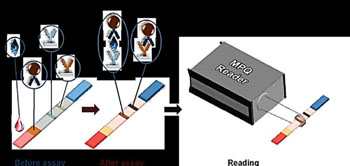Biosensor Test System Developed Using Magnetic Nanoparticles
By LabMedica International staff writers
Posted on 14 Feb 2016
A new biosensor test system based on magnetic nanoparticles has been developed and it is designed to provide highly accurate measurements of the concentration of protein molecules in various samples, including opaque solutions or strongly colored liquids.Posted on 14 Feb 2016
The analysis is conducted using small test strips made of porous material with two test lines. A droplet of the sample liquid is applied to one end of the strip and after a short period the result is shown as the activation of one or both lines. The test can be done quickly and does not need to be carried out by specially trained staff; tests can easily be performed next to a patient or even in field conditions.

Image: Schematics of the magnetic particle quantification (MPQ) platform: the antigen is the test protein (e.g., PSA). MP is the magnetic nanoparticle; the upside down Y is the antibody to the test protein. The test antibodies (the blue Ys) capture the test protein, and the control antibodies (the yellow Ys) capture the antibodies with the nanoparticles (Photo courtesy of Moscow Institute of Physics and Technology).
Scientists at Moscow Institute of Physics and Technology (Russia) have developed a dry-reagent immunomagnetic (DRIM) biosensing platform for rapid high-precision quantitative analyses for in vitro diagnostics. The platform combines the advantages of immunochromatography with highly sensitive quantification of 200-nm magnetic nanoparticles (MP) from the entire volume of lateral flow membranes. At molecular level, the magnetic nanoparticles "link" with antibodies to the required protein and then they are placed on a porous plate close to the intended point of contact with the test solution.
The new system was tested by measuring 25 pg/mL of prostate-specific antigen in the blood as the "healthy" range is anything lower than 4 ng/mL. Prostate-specific antigen is one of the most commonly monitored markers in clinical examinations on men. The scientists used their own patented method magnetic particle quantification (MPQ) to precisely count magnetic nanoparticles by their nonlinear magnetization. Using this method, scientists are able to record anything above 60 zmol (zeptomole; i.e., a factor of 10-21) of nanoparticles in a linear range exceeding ten million times in about 30 minutes. These parameters have never been recorded at this level before. The method involves applying an alternating magnetic field to the nanoparticles at two frequencies and monitoring the induction response at combinatorial frequencies.
The combination of reliability, accessibility, and high accuracy and sensitivity of the new method means that it is likely to make a rapid transition from a laboratory prototype to mass production. The developers have not yet given a specific timeframe, but they emphasize that their test system can be used not only to diagnose diseases, but also for a number of other applications. The study was published online on December 21, 2015, in the journal Biosensors and Bioelectronics.
Related Links:
Moscow Institute of Physics and Technology














